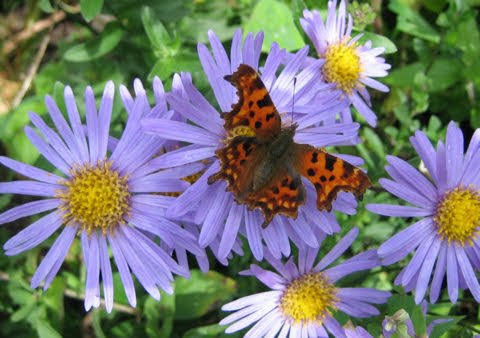 |
| Comma on michaelmas daisies |
Surveys of the wildlife started with Mel’s butterfly records and photos. It appears from Mel's booklet (1991) that Barbara Greenwood, then Hon Recording Officer for Wirral Group of Cheshire Wildlife Trust, carried out a survey of the Park in 1984. So there was some early conservation interest from what became Wirral Wildlife.
 |
| Small tortoiseshell |
Hilary did a further plant species list in 1991 and Mel got Liverpool Botanical Society to visit to do a fuller one. By 1998, we had decided roughly how to manage the main parts of the Park, and Hilary wrote the first formal management plan. From 2002 we started the detailed butterfly records which still continue. Various other records arrived as we got specialists to visit.
Paul Loughnane organised and led the practical workdays, which became monthly from September to April once we had the Park in reasonable order. Paul is also secretary of Wirral Countryside Volunteers (WCV) and the relationship between the two organisations became closer in 2003 when the group relocated their tools to the park.
The WCV have a small tree nursery on site, and the Park benefits from their expert work coppicing, hedge-laying and scything, and training others in these skills.
 |
| Paul Loughnane, secretary of Wirral Countryside Volunteers (WCV) |
 |
| Paul scything at the Butterfly Park |
 |
| Coppiced poles |
Other training courses developed e.g. Hilary’s on grasses and later on wildflowers, ones on bees led by Carl Clee and Tony Parker, ones on butterflies joint with Butterfly Conservation. Since March 2018 apple grafting courses have been held ran by Dave Ellwand of Wirral Tree Wardens followed by apple pressing in October.
 |
| Meadow creation study day |
All our terrestrial insects have found their own way there, helped by management e.g. planting alder and purging buckthorns, which eventually persuaded visiting brimstones to breed in 2014 (some 12 years after a local Cub group planted the main alder buckthorn row).
Later on, for several years Manchester University brought first year students to the Butterfly Park to see nature conservation in action. The local branch of the Chartered Institute of Ecology and Environmental Management visited twice to see and discuss habitat creation and management for invertebrates.
We did not envisage, in the 1990s, that by 2020 insect conservation would have become a major topic, as the extent of insect decline nationally and internationally has become apparent.










No comments:
Post a Comment